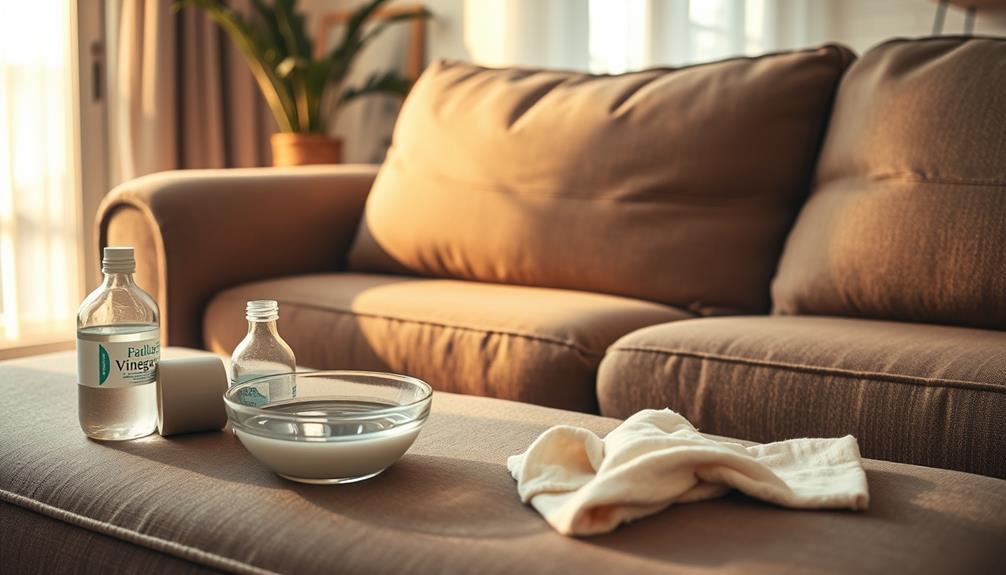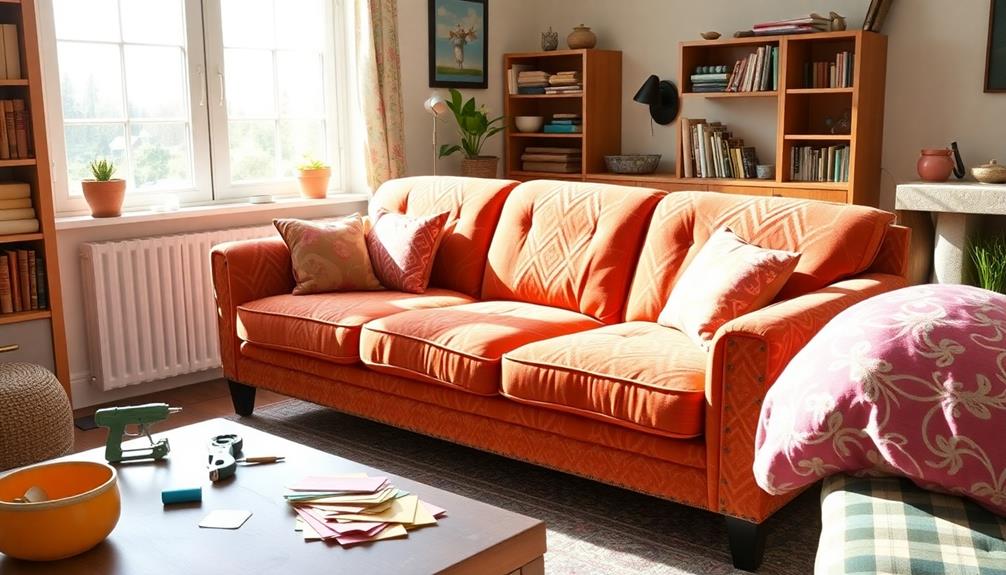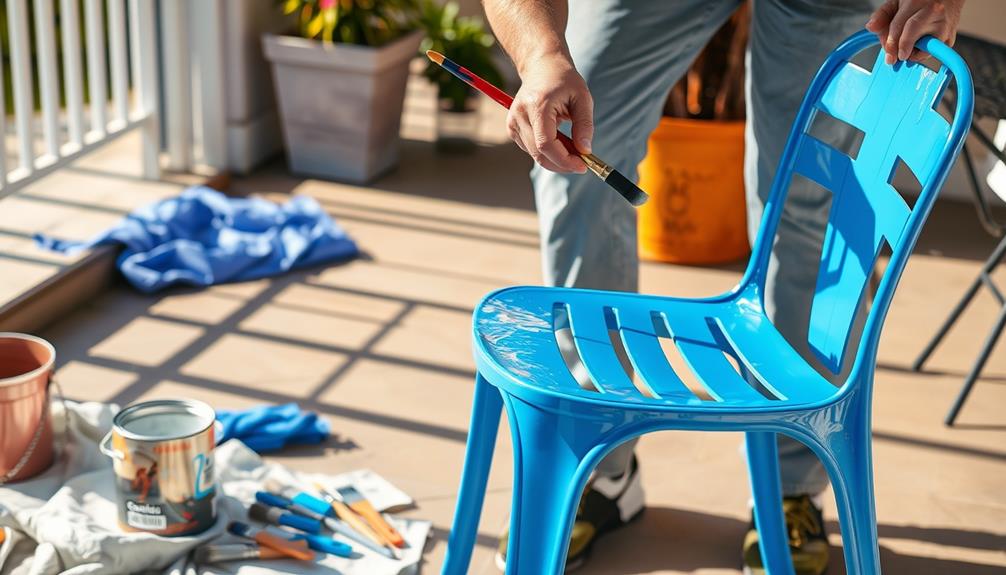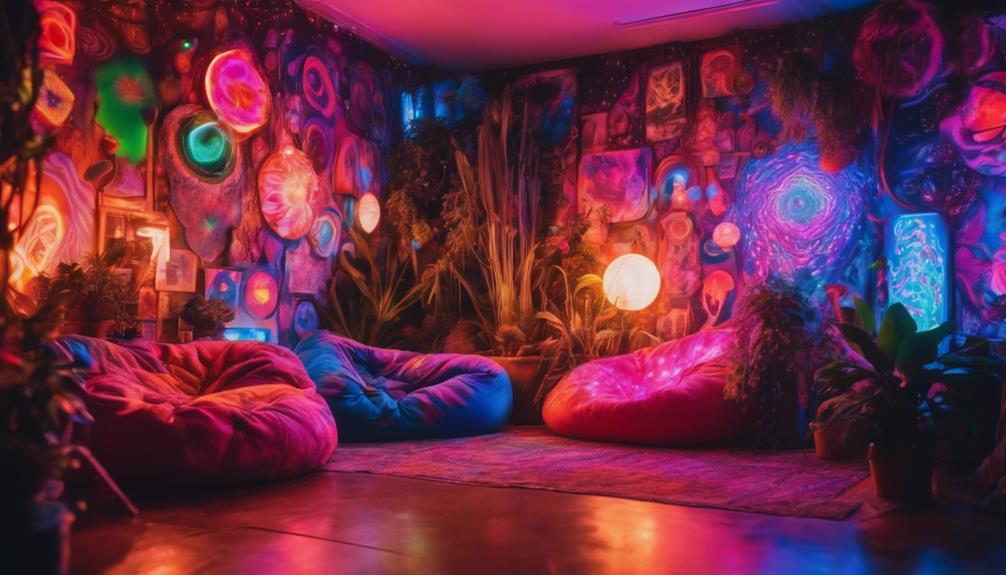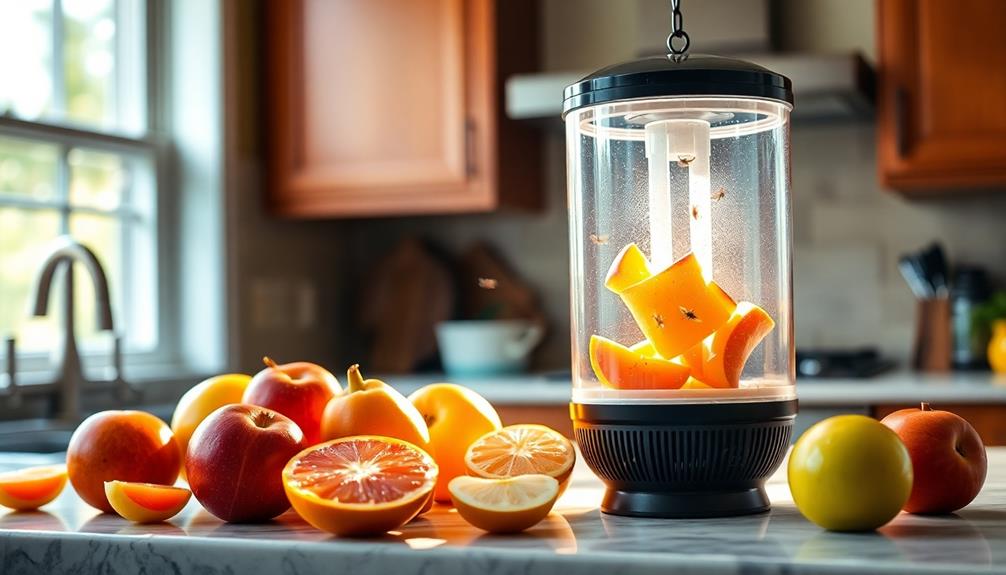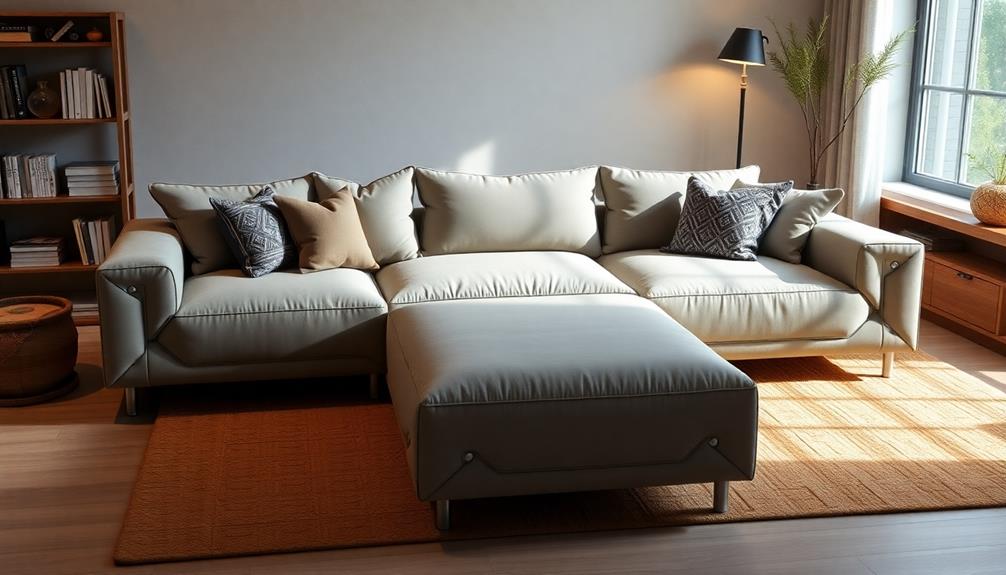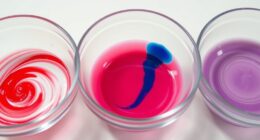To effectively eliminate mold from fabric furniture without using bleach, it is important to prioritize safety by wearing gloves and a mask. Create a solution by mixing equal parts white vinegar and water, and apply it onto the affected areas. Allow the solution to sit for approximately 10 minutes before thoroughly rinsing it off. In case of stubborn stains, consider using hydrogen peroxide or a baking soda paste. After cleaning, ensure that the fabric is completely dried in sunlight to prevent the mold from reappearing. It is advisable to regularly inspect your furniture and maintain low humidity levels to prevent future mold growth. There are numerous additional steps you can take to ensure that your furniture remains free from mold.
Key Takeaways
- Use a solution of equal parts white vinegar and water to effectively kill mold on fabric furniture.
- Apply 3% hydrogen peroxide directly to stubborn mold stains for deeper cleaning.
- Vacuum upholstery with a HEPA filter to remove loose mold spores before cleaning.
- Dry the fabric completely in direct sunlight to further eliminate mold and prevent regrowth.
- Maintain indoor humidity levels below 60% to inhibit future mold growth on furniture.
Identifying Mold on Fabric
When you notice black, green, or white spots on your fabric furniture, it's important to act quickly, as these could be signs of mold. Mold often appears with a fuzzy texture, making it easy to identify on upholstered furniture.
Besides visible mold, a musty odor is a strong indicator of mold growth, suggesting moisture issues that need addressing. To prevent mold growth, it's vital to maintain low humidity levels below 60% and regularly check for potential moisture sources, as improper ventilation can exacerbate the problem cold medications overview.
High humidity levels, particularly above 60%, create ideal conditions for mold to thrive. Common sources of moisture, like spills or leaks, can quickly lead to mold growth on your furniture if not managed properly.
Regular inspections of your fabric furniture in damp areas are important for early detection of mold. Ignoring these signs can lead to extensive damage and serious health risks, as certain types of mold, such as Aspergillus and Stachybotrys, can pose significant threats.
Safety Precautions Before Cleaning
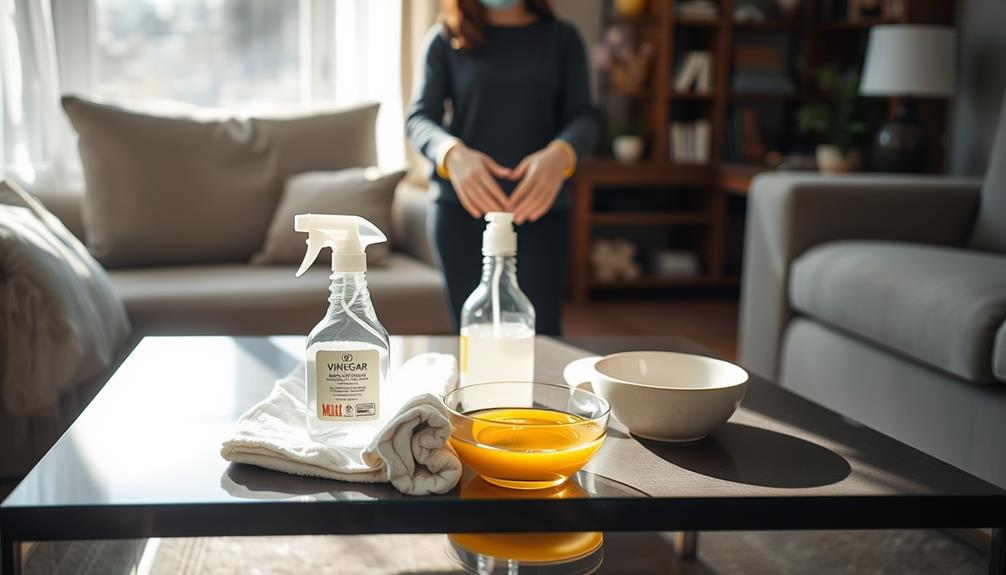
Before you start cleaning mold from your fabric furniture, make certain you're geared up with protective equipment like gloves and a mask.
It's also essential to ventilate the area well by opening windows or using a fan to keep mold spores at bay.
Additionally, it's wise to reflect on the emotional impact of dealing with mold issues, as it may cause stress for some individuals.
Remember that seeking emotional and psychological support during challenging tasks can be beneficial.
Don't forget to prepare the space by keeping pets and kids away to guarantee everyone's safety during the process.
Protective Gear Essentials
Your safety is paramount when tackling mold on fabric furniture, so don't skip the necessary protective gear. Start with rubber or latex gloves to protect your skin from mold exposure and harsh cleaning products. A mask or respirator with a HEPA filter is essential to prevent inhaling mold spores and fumes during cleaning.
Opt for long sleeves and pants to further shield your skin from direct contact with both the mold and the cleaning agents. This added layer reduces the risk of irritation and keeps you safe as you work.
Here's a quick reference table to remind you of the essentials:
| Protective Gear | Purpose | Importance |
|---|---|---|
| Gloves | Protect skin from mold exposure | Prevents irritation and allergic reactions |
| Mask/Respirator | Filters out mold spores and cleaning fumes | Reduces inhalation risks |
| Long Sleeves/Pants | Shields skin from direct contact | Minimizes risk of irritation and exposure |
Remember to keep pets and children away from the cleaning area to avoid any accidental exposure to mold and cleaning products. Your well-being is vital, so gear up before you plunge into action!
Ventilation Importance
Proper ventilation is essential for safely removing mold from fabric furniture. Before you start the cleaning process, make sure the area is well-ventilated by opening windows and using fans to promote airflow. This step helps reduce inhalation risks associated with mold spores, which can be harmful to your health.
Additionally, having a good understanding of seasonal variations in humidity can aid in preventing mold growth. Adequate ventilation also minimizes moisture buildup, making it easier to prevent mold regrowth after you've cleaned the furniture.
Assess the room's humidity levels, aiming to keep indoor humidity below 60%. High humidity can encourage mold growth, so maintaining a drier environment is vital. By making sure proper airflow, you not only create a safer workspace but also help the cleaned furniture dry more quickly, decreasing the chances of mold returning due to lingering dampness.
Additionally, it's wise to keep pets and children away from the cleaning area during this time. This precaution protects them from potential exposure to mold and cleaning agents used in the removal process.
Area Preparation Steps
Guaranteeing a safe cleaning environment is essential when tackling mold on fabric furniture. Start by wearing protective gear, including gloves, a mask, and long sleeves, to prevent skin irritation and respiratory issues.
Next, verify your cleaning area is a well-ventilated space. Open windows or turn on fans to minimize inhalation risks and disperse any mold spores that may be released during the process.
It's best to move fabric furniture outdoors or to a designated well-ventilated space to contain spores and avoid contaminating areas of your home. Before you begin cleaning, inspect the furniture for signs of extensive damage. If it's heavily infested, consider contacting a professional for help instead of attempting a DIY solution.
Make sure to keep pets and children away from the cleaning area. Their accidental exposure to mold and cleaning agents can lead to health risks.
Effective Natural Cleaning Solutions
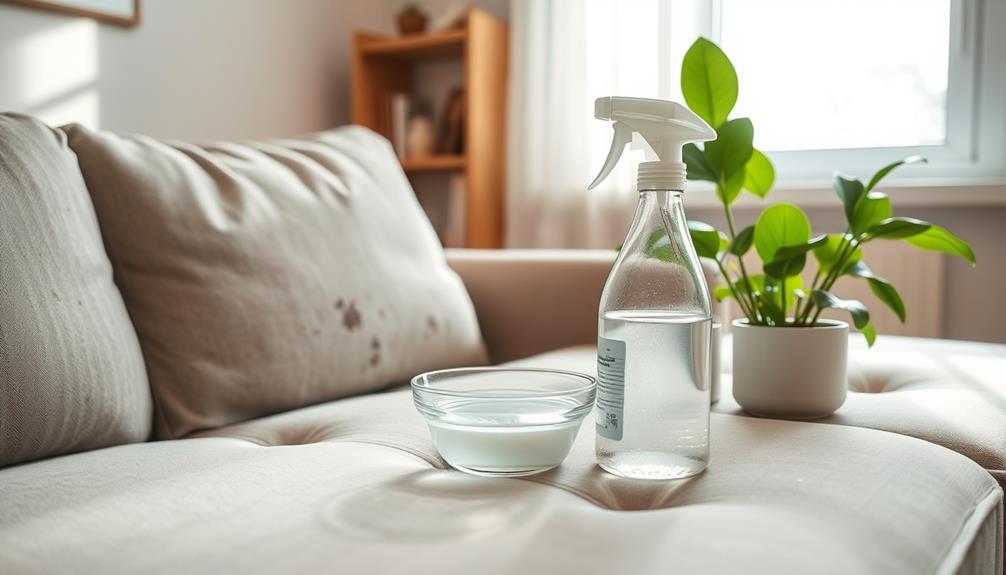
When tackling mold on fabric furniture, several effective natural cleaning solutions can make the job easier. One of the best options is white vinegar, a powerful natural cleaning agent that you can spray undiluted on moldy areas. It kills up to 82% of mold species without damaging the fabric.
Another great choice is a hydrogen peroxide solution at a 3% concentration. Apply it directly to mold stains; it acts as a natural antifungal and rinses off safely.
Baking soda is also effective. Mix it with water to form a paste, which can scrub away mold while absorbing moisture and odors.
For lighter stains, consider using lemon juice. While it may require multiple applications, it has natural antibacterial properties that help clean mold.
Finally, don't overlook tea tree oil. When diluted in water, just a few drops in a spray bottle can effectively eliminate mold and prevent future mold growth.
Using these natural cleaning solutions not only helps you remove mold from fabric but also keeps your furniture safe from harsh chemicals.
Step-by-Step Cleaning Techniques
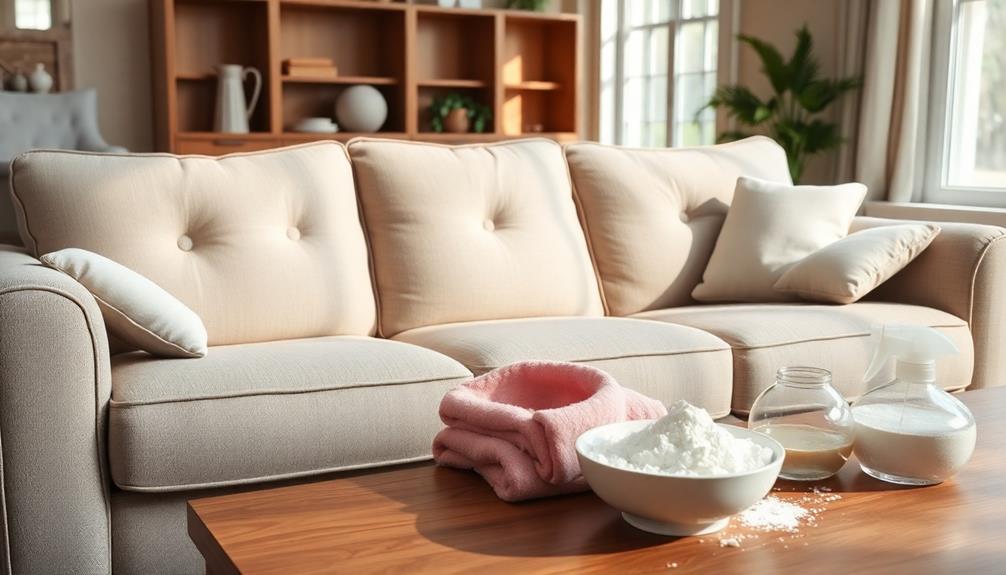
To effectively remove mold from fabric furniture, follow these simple steps.
Start by vacuuming the affected upholstery with a HEPA filter attachment. This will help remove loose mold spores before you apply any cleaning solutions.
Next, create a cleaning solution by mixing equal parts of white vinegar and water. Pour the solution into a spray bottle and apply it directly to the moldy areas. Allow it to sit for a few minutes to penetrate the mold.
For stubborn mold stains, soak a cotton pad in 3% hydrogen peroxide and place it on the affected spots. Let it sit for 10 minutes, then gently scrub with a brush.
After cleaning, rinse the fabric thoroughly with water to remove any residue from the cleaning agents. Make sure your furniture dries completely in direct sunlight to prevent mold regrowth. Additionally, for tougher odors or stains, you can clean your sofa with baking soda by sprinkling a generous amount on the fabric and letting it sit for 15-20 minutes before vacuuming it off. This method helps to absorb lingering smells and refresh the upholstery. Regularly cleaning with natural solutions like baking soda can prolong the life of your furniture and keep it looking and smelling fresh. For particularly stubborn spots, you may want to research specific methods on **how to clean fabric sofa stains**, depending on the type of stain and fabric involved. In some cases, a mixture of mild dish soap and warm water can be effective for spot cleaning, but always test any solution on an inconspicuous area first. Consistent maintenance not only ensures a cleaner appearance but also extends the durability of your furniture.
To keep your fabric furniture mold-free in the future, regularly inspect it and maintain humidity levels below 60%.
- Vacuum with a HEPA filter
- Use a vinegar and water solution
- Dry in direct sunlight
Specialized Mold Removal Methods
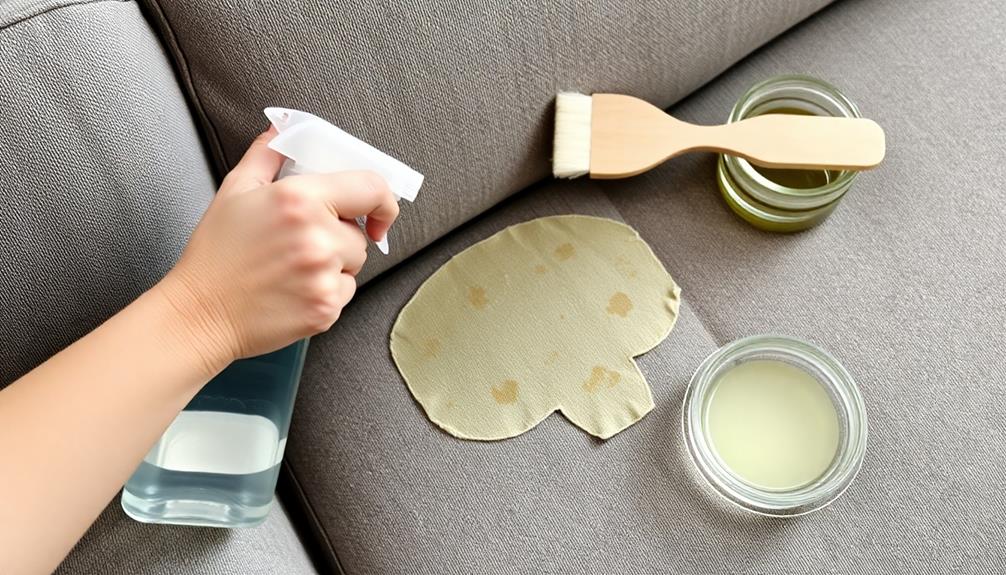
For tougher mold problems that regular cleaning methods can't handle, specialized mold removal techniques might be necessary. Here are some effective methods to contemplate:
| Method | Description |
|---|---|
| 3% Hydrogen Peroxide | Apply directly to mold stains, let sit, then rinse. |
| Water and White Vinegar | Mix equal parts, spray on affected areas, scrub gently. |
| Tea Tree Oil Solution | Dilute with water, apply for natural mold fighting. |
| Dry Fog System | Disperses sterilant droplets to penetrate surfaces. |
| Professional Services | Ideal for vintage fabrics; hire a remediation company. |
When you want to remove the mold effectively, you can start with the water and white vinegar solution, as it's safe for most fabrics. For stubborn mold stains, contemplate using a 3% hydrogen peroxide solution; just apply the solution and rinse afterward. If you're dealing with delicate fabrics, it may be best to consult a professional mold remediation company. Additionally, using a dehumidifier can help prevent further growth while you clean the mold. By employing these specialized methods, you can tackle mold issues and maintain your fabric furniture's integrity.
Prevention Strategies for Future Growth
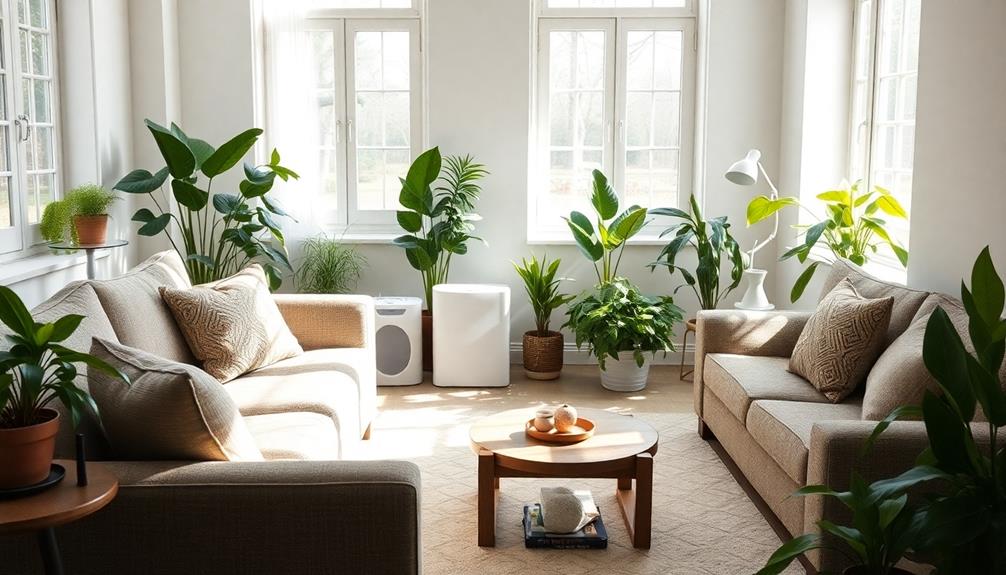
Mold can be a persistent problem, but you can take several effective steps to prevent its growth on fabric furniture. Start by keeping indoor humidity levels below 60%. Use dehumidifiers and guarantee proper ventilation to reduce moisture levels in your home.
Regularly clean and inspect fabric furniture for early signs of mold, like discoloration or musty odors, so you can address issues promptly.
Here are some actionable strategies to keep your furniture mold-free:
- Store items in moisture-proof containers to avoid exposing them to dampness.
- Use fabric protectants to create a barrier against moisture and mold spores, enhancing your upholstery's longevity.
- Promptly clean and dry any spills or water damage to prevent mold from establishing itself.
When to Seek Professional Help
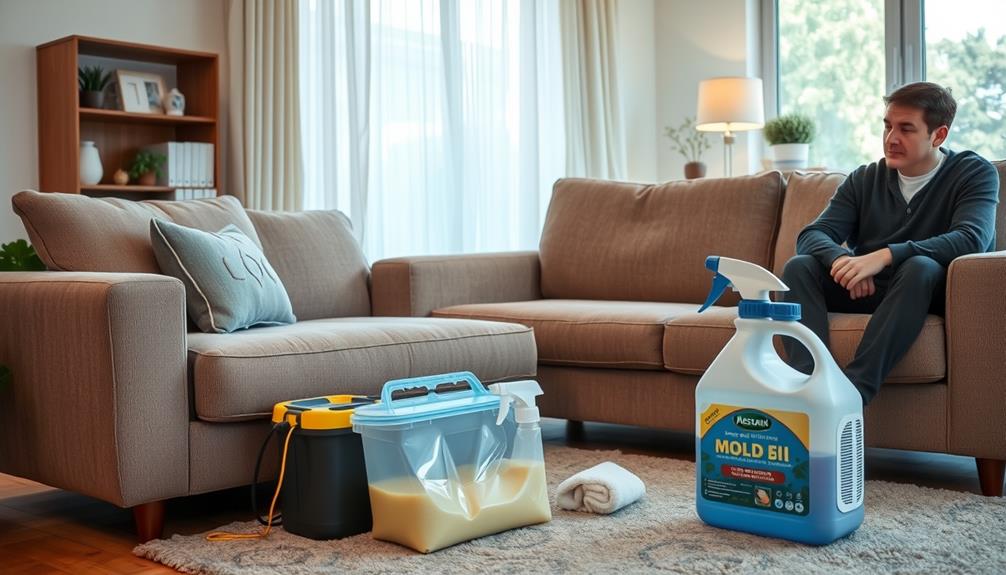
Even with the best prevention strategies in place, mold can still find a way to thrive on your fabric furniture. If you notice extensive mold infestations or large areas affected, it's time to seek professional help.
Professionals specializing in mold removal have the specialized equipment necessary for thorough removal, guaranteeing that the mold is eliminated safely and effectively.
If you're dealing with delicate fabrics like silk or wool, DIY cleaning methods might cause more harm than good. These materials often require professional care to avoid damage.
Additionally, if you experience allergic reactions or respiratory issues while removing mold from fabric, it's vital to consult a professional immediately. Mold poses significant health risks, and you shouldn't take chances with your well-being.
For furniture that has sustained heavy water damage, a professional assessment is indispensable. They can determine whether replacement is necessary and recommend appropriate actions.
Frequently Asked Questions
How Do You Get Mold Out of Fabric Furniture?
To get mold out of fabric furniture, apply undiluted white vinegar, let it sit, then scrub with a soft brush. For stubborn spots, try a baking soda paste, and always dry the furniture in sunlight.
How Long Does It Take Vinegar to Kill Mold on Fabric?
You might think mold removal is quick and easy, but vinegar typically takes about one hour to kill most mold on fabric. Spray it on, let it sit, then scrub for the best results.
Will Vinegar Kill Mold on Couch?
Yes, vinegar will kill mold on your couch. Just spray it undiluted on the affected areas, let it sit for ten minutes, then scrub gently and rinse thoroughly to remove the mold effectively.
How Do I Clean Mold and Not Ruin Furniture?
Cleaning mold from your furniture feels challenging, right? Start by mixing equal parts vinegar and water. Spray, scrub gently, and let sunlight do the rest. Just remember to spot test first to protect your fabric!
Conclusion
By following these steps, you can reclaim your fabric furniture from the clutches of mold, much like a knight rescuing a castle from a dark enchantment. Remember to stay vigilant and embrace the natural cleaning solutions that help banish those pesky spores. With a bit of care and the right techniques, your furniture can shine once again, free from the shadows of mold, allowing your living space to breathe and flourish like a garden kissed by the sun.
